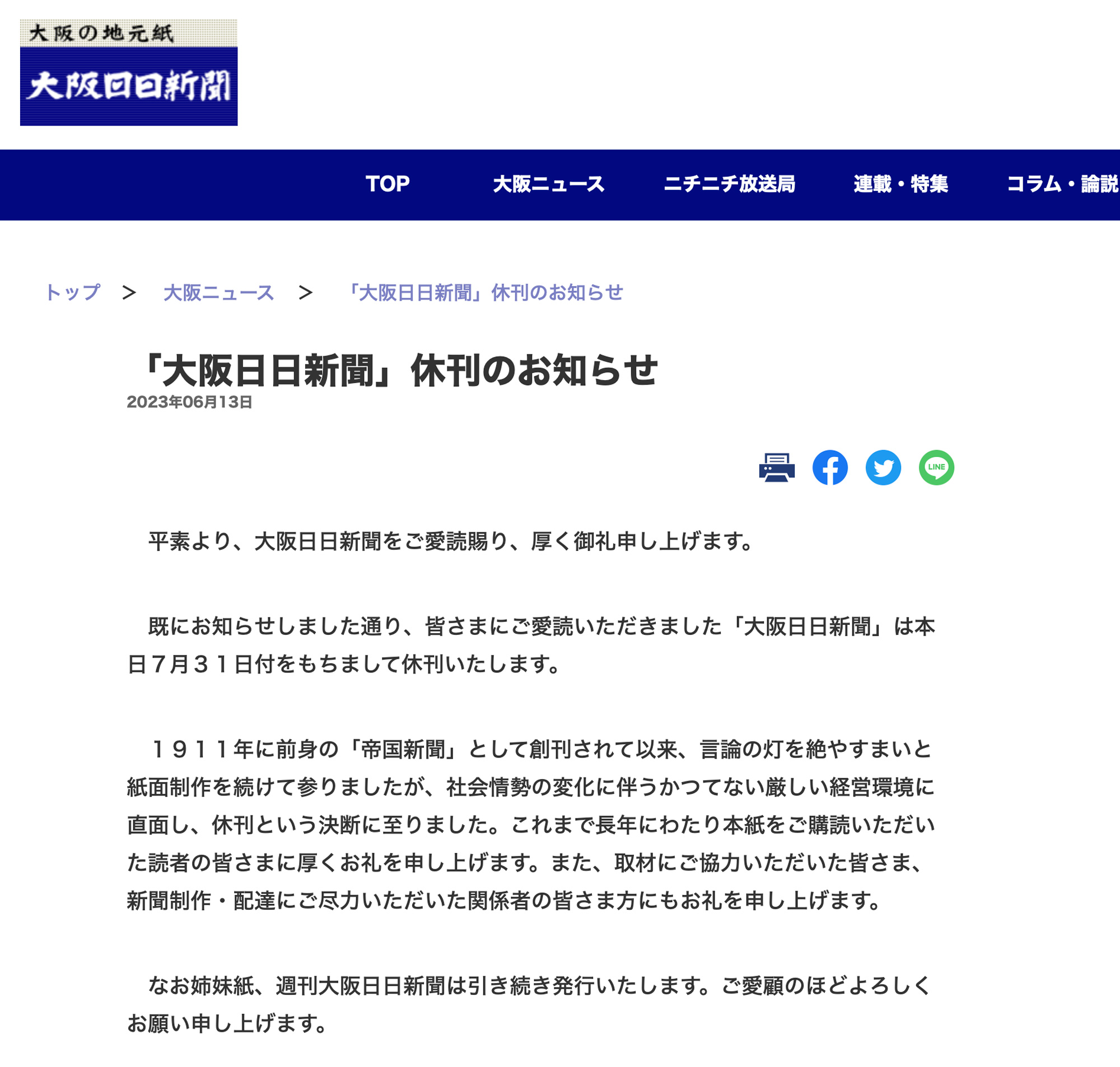Issue:
October 2023
The newspaper’s closure should be a clarion call to save local print media, says one of its former reporters

On July 31, the local newspaper Osaka Nichinichi Shimbun printed its final edition. The closure was another sad milestone in the slow decline of the print media in Japan. Total circulation stood at 33 million in 2022, down by 6% from the previous year and by 38% from 2011. Many younger people have gravitated to free online content.
At the time of its closure, the Nichinichi Shimbun had seven reporters and a circulation of about 5,000. Although the paper did not have the firepower to cover the entire Osaka metropolis, it still had a dedicated readership, attracted by its coverage of local news, amateur sports, culture and entertainment, as well as the local government and economy.
The reporters worked hard to keep the paper going with a dwindling number of staff. However, there was no prospect of a rebound, and on June 13 and July 31, the Shin Nihonkai Shimbun, which publishes the paper along with the Nihonkai Shimbun – a regional newspaper in Tottori Prefecture – broke the bad news. “Faced with an unprecedentedly severe business environment due to changes in social conditions, we have reached the decision to suspend publication,” it said on its website.
The Osaka Nichinichi Shimbun was launched in 1911 as the Teikoku Shimbun and was given its current title the following year. For many years it also published an evening edition. It was acquired by the Shin Nihonkai Shimbun in August 2000, and published a morning edition as a daily regional newspaper for about 23 years.
Osaka is a fierce newspaper market, where national newspapers also compete with each other, so a local paper trying to get a foothold was considered reckless. However, in addition to hiring reporters from the evening edition, the company sent talented reporters from Nihonkai Shimbun. In the years following the shift to a morning edition, the company welcomed experienced new journalists.
The company created a vibrant workplace with a mixed workforce from different backgrounds, and assigned reporters to cover particular fields, such as social affairs, sports, administration, and economics. At its peak, the paper employed 30 editorial staff, and each team competed to produce serials and undertake new projects.
At the same time, the company was also working to improve its sales system. Specialized sales outlets were set up in major wards, and sales staff were also deployed from the Nihonkai Shimbun. Although the company started from scratch in a highly competitive district, it cooperated with the dedicated sales outlets for a time to increase circulation through sales plans linked to articles, aggressive posting, and other measures.
However, as readers began to drift away from newspapers, circulation remained sluggish, peaking at 8,100. The recent sharp rise in the cost of materials and delivery, and especially last year's sharp rise in the cost of paper, dealt a fatal blow, and the decision was made to pull the plug.
Osaka Nichinichi Shimbun reporters have been deeply involved in the community, reporting mainly on school and municipal events, school sports competitions, local culture and entertainment, traditional events at shrines and temples, local government, and the state of small and medium-sized businesses and shopping districts – all areas that national newspaper find difficult to penetrate.
However, as the business environment worsened, the company stopped hiring new employees, and the reporters who had come from the Nihonkai Shimbun gradually returned to Tottori. Journalists saw few prospects for the future and left the company. The inability to maintain our editorial policy of emphasizing the local community led to a vicious cycle in which even more reporters quit.
Those reporters had their own area of expertise, so I fear that it will now become harder for the small voices of the community to be heard, and that records rooted in the community will cease to exist.
Yet we shouldn’t write off the local print media. Yes, readers are shifting away from newspapers due to the rise of online media, declining advertising revenues, and soaring material and delivery costs. But small local newspapers survive, and as far as I know, they continue to use tried and trusted methods to keep going.
One is a commitment to sincere and careful reporting to maintain a long-lasting relationship of trust with the people they cover. The other is building face-to-face relationships by regularly holding events such as town walks, lectures, and get-togethers with readers. This could be one way in which local papers can continue to survive, since their bigger print rivals do not engage with the community in the same way. As for me, I am reflecting on the things I did not get right as a reporter for the Osaka Nichinichi Shimbun.
Isao Kinoshita joined the Osaka Nichinichi Shimbun in 2001. As an economics reporter, he covered finance, small and medium-sized enterprises, economic organizations, etc. As an administrative reporter, he covered Osaka Prefecture, Osaka City, and other areas. He has written about issues such as plans to turn Osaka into a metropolis, the bid to open a casino/integrated resort in the city, and the finances of small and medium-sized enterprises. Kinoshita currently writes freelance articles for several publications, including the Weekly Economist.

